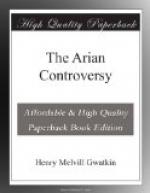Looking back from our own time, we should say that it was not a promising course for Valens to support the Homoeans. They had been in power before, and if they had not then been able to establish peace in the churches, they were not likely to succeed any better after their heavy losses in Julian’s time. It is therefore the more important to see the Emperor’s motives. No doubt personal influences must count for a good deal with a man like Valens, whose private attachments were so steady. Eudoxius was, after all, a man of experience and learning, whose mild prudence was the very help which Valens needed. The Empress Dominica was also a zealous Arian, so that the courtiers were Arians too. No wonder if their master was sincerely attached to the doctrines of his friends. But Valens was not strong enough to impose his own likings on the Empire. No merit raised him to the throne; no education or experience prepared him for the august dignity he reached so suddenly in middle life. Conscientious and irresolute, he could not even firmly control the officials. He had not the magic of Constantine’s name behind him, and was prevented by Valentinian’s toleration from buying support with the spoils of the temples.
Under these circumstances, he could hardly do otherwise than support the Homoeans. Heathenism had failed in Julian’s hands, and an Anomoean course was out of the question. A Nicene policy might answer in the West, but it was not likely to find much support in the East outside Egypt. The only alternative was to favour the Semiarians; and even that was full of difficulties. After all, the Homoeans were still the strongest party in 365. They were in possession of the churches and commanded much of the Asiatic influence, and had no enmity to contend with which was not quite as bitter against the other parties. They also had astute leaders, and a doctrine which still presented attractions to the quiet men who were tired of controversy. Upon the whole, the Homoean policy was the easiest for the moment.
[Sidenote: The exiles exiled again.]
In the spring of 365 an imperial rescript commanded the municipalities, under a heavy penalty, to drive out the bishops who had been exiled by Constantius and restored by Julian. Thereupon the populace of Alexandria declared that the law did not apply to Athanasius, because he had not been restored by Julian. A series of dangerous riots followed, which obliged the prefect Flavianus to refer the question back to Valens. Other bishops were less fortunate. Meletius had to retire from Antioch, Eustathius from Sebastia.
[Sidenote: Semiarian embassy to Liberius.]
The Semiarians looked to Valentinian for help. He had received them favourably the year before, and his intercession was not likely to be disregarded now. Eustathius of Sebastia was therefore sent to lay their case before the court of Milan. As, however, Valentinian had already started for Gaul, the deputation turned aside to Rome and offered to Liberius an acceptance of the Nicene creed signed by fifty-nine Semiarians, and purporting to come from the council of Lampsacus and other Asiatic synods. The message was well received at Rome, and in due time the envoys returned to Asia to report their doings before a council at Tyana.




